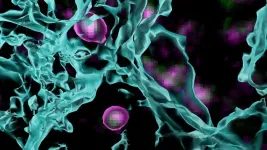(Press-News.org) Seoul National University(SNU) College of Engineering announced that a joint research team led by Professor Ki Tae Nam from the Department of Materials Science and Engineering at SNU and Professor Junil Choi from the Korea Advanced Institute of Science and Technology (KAIST) has developed a novel visible light communication encryption technology with high security using chiral nanoparticles.
Just as a lighthouse provides a guiding beam in the vast darkness of the sea, light-based information transmission has been a crucial means of communication throughout human history. Recently, next-generation communication technology based on visible light, which possesses high frequencies and linearity, has gained attention. It offers advantages such as integration with lighting systems and is free from the electromagnetic interference associated with conventional communication networks. With high security and fast transmission speeds, visible light communication is particularly suitable for local communication systems, especially in military operations involving vehicles, drones, and personnel.
In addition to intensity and wavelength (color), light can carry a vast amount of information through polarization. For instance, 3D movies use polarized filters to deliver two different polarized images to the viewer's eyes, creating a sense of depth. Recently, efforts have been made to improve the security and performance of visible light communication, including the incorporation of technologies related to polarization, such as quantum information communication based on the superposition of polarization.
The SNU-KAIST joint research team focused on how light polarization can be significantly modulated through interaction with nanomaterials. In this study, they developed an innovative visible light communication encryption technology based on new materials. The core of this technology lies in chiral nanomaterials, which exhibit a symmetric structure when viewed in a mirror but do not overlap. These materials can significantly adjust the tilt of the polarization axis or its rotational properties. Having previously published two papers in 2018 and 2022 in the prestigious journal Nature on “the synthesis and optical device application of chiral nanoparticles with world-class polarization control performance,” the research team has now introduced a visible light communication encryption technology that cannot be replicated or intercepted without detailed information about the nanoparticles.
The chiral nanoparticles used in this technology are created by twisting their crystal structure using biomolecules like proteins and DNA, which possess natural chirality. The optical properties of these nanoparticles cannot be replicated without complete sequence information of the biomolecules used in their synthesis. Therefore, chiral nanoparticles function like fingerprints or unclonable keys in visible light communication, allowing only the receiver with the actual nanoparticles to correctly decode the information. This encryption technology is expected to have significant utility in secure point-to-point communication systems, such as those used in military operations involving drones.
Furthermore, the research team developed a spatiotemporal polarization control device capable of transmitting encrypted polarization information. By combining quantum nanorods, which efficiently emit polarized light, with nanowire materials that provide rotational properties to the light, they used 3D printing to fabricate a polarization control device with hundreds of micrometers of spatial resolution and nanoseconds of temporal resolution, allowing all polarization states to be represented without restriction. The transmitting unit can encrypt and transmit polarization information in a form suited to the polarization control properties of the nanoparticles using this device. This technology is expected to be the foundation for mass production of devices that can control spatiotemporal polarization without being constrained by form factor.
Professor Ki Tae Nam from SNU’s Department of Materials Science and Engineering said, “This research, which actively combines new material technologies with communication technologies, played a crucial role in developing the world’s first and only visible light communication encryption technology. We expect this technology to not only contribute to national defense but also be commercialized rapidly in industrial fields like display technology.” Professor Junil Choi from KAIST’s School of Electrical Engineering added, “This outstanding research result was achieved through joint efforts between material science and electrical engineering experts. In the future, we aim to further develop visible light communication technology based on nanoparticles to create communication systems that are fundamentally impossible to eavesdrop on.” Co-first author Jeong Hyun Han also stated, “We anticipate that this encryption system will act as a platform with great scalability and impact in the field of optical information transmission based on polarization.”
This research was supported by the Future Defense Technology Development Program of the Agency for Defense Development, the Basic Research Laboratory Program of the National Research Foundation of Korea, and private support from LG Display. The research outcome, which has been recognized for its significance, was published in the prestigious multidisciplinary journal Nature Communications on September 27.
□ Introduction to the SNU College of Engineering
Seoul National University (SNU) founded in 1946 is the first national university in South Korea. The College of Engineering at SNU has worked tirelessly to achieve its goal of ‘fostering leaders for global industry and society.’ In 12 departments, 323 internationally recognized full-time professors lead the development of cutting-edge technology in South Korea and serving as a driving force for international development.
END
SNU-KAIST researchers jointly develop a new visible light communication encryption technology using chiral nanoparticles
Developed a foundation for practical applications in military communications and functional displays using unclonable nanoparticles.
2024-10-10
ELSE PRESS RELEASES FROM THIS DATE:
HPTN 091 study shows encouraging uptake and adherence to oral PrEP among transgender women
2024-10-10
DURHAM, N.C. – Researchers from the HIV Prevention Trials Network (HPTN) presented results from HPTN 091 (“I Am Study”) at the HIVR4P 2024 conference in Lima, Peru. The study examined the acceptability and feasibility of an integrated multicomponent strategy to enhance daily oral HIV pre-exposure prophylaxis (PrEP) uptake and adherence among transgender women in a randomized immediate versus deferred design. The integrated care strategy included the provision of gender-affirming hormone ...
Gonzalez receives award to study causes of racial disparities in amputation rates in Indiana
2024-10-10
INDIANAPOLIS --More than 8 million people, ages 40 and older, living in the U.S. are affected by peripheral arterial disease, a lifelong medical condition and the most common cause of limb amputation in the country. A data scientist, health services researcher and vascular surgeon who studies health equity, Andrew A. Gonzalez, M.D., J.D., MPH, of the Regenstrief Institute and the Indiana University School of Medicine, has received a 2024 Ralph W. and Grace M. Showalter Research Trust award to conduct a new study, Exploring Causes of Racial Disparities in Amputation Rates in Indiana.
Dr. ...
Mount Sinai opens state-of-the-art center for patients with complex conditions including Lyme disease and long COVID
2024-10-10
Mount Sinai’s Department of Rehabilitation and Human Performance has announced the grand opening of the Cohen Center for Recovery From Complex Chronic Illnesses (CoRE), providing clinical care for patients with conditions such as long Lyme disease/Lyme+, long COVID, and other infection-associated complex chronic illnesses such as myalgic encephalomyelitis/chronic fatigue syndrome (ME/CFS) and Ehlers-Danlos syndrome (EDS).
Supported by philanthropy from various donors, including an inaugural gift from Beth and ...
$14M NIH grant funds gene-editing research for rare metabolic diseases at Penn and CHOP
2024-10-10
PHILADELPHIA— A $14M grant will fund research on gene-editing therapies for rare metabolic diseases at the Perelman School of Medicine at the University of Pennsylvania (Penn) and Children’s Hospital of Philadelphia (CHOP). The research will focus specifically on developing therapies for urea cycle disorders, which impact roughly 1 in every 35,000 children. Using a form of CRISPR technology, the ultimate vision of the four-year grant is to create a platform for rapid development of personalized gene-editing therapies for ...
One experiment: The brain’s landscapers
2024-10-10
Imagine yourself sometime in the far future aboard a routine rocket to Mars. Someone just spilled their drink. Without gravity, it collects in floating blobs that ripple right before your eyes. Now freeze.
What you see might look something like the above image from Cold Spring Harbor Laboratory’s (CSHL’s) Cheadle lab. But those purple and green blobs aren’t the floating remains of somebody’s drink. They’re mysterious cells in the brain’s visual cortex called OPCs.
The visual cortex processes everything we see. Incoming visual information is ...
AI-supported dermatology: Now for darker skin tones too, thanks to a new data set
2024-10-10
In many countries in Africa, up to nine out of ten children suffer from a skin problem, and there are far too few local dermatologists. Artificial intelligence could help with diagnosis, but needs to be trained with the relevant images, so researchers have created a new data set for dark skin tones.
Demand is high, the lack of dermatologists acute: in many countries in Africa, there is less than one dermatology specialist per one million people – compared to the World Health Organization (WHO) recommendation of ...
Understanding how smiling influences relationship building during real-life conversations
2024-10-10
Smiling during conversations creates warmth, making people feel more comfortable and connected. For example, a friendly smile when meeting someone new can ease nervousness. A smile can soften tension in a debate, showing respect among the participants despite disagreement. In fact, extensive studies have been conducted in the past in an attempt to understand smiling interactions in a natural conversation. Despite these studies, however, little is known about the extent to which one’s smile influences or gets affected by the other person’s smile during a conversation.
A new study sought to investigate this by quantifying ...
British Heart Foundation Data Science Centre launches first open challenge to explore AI ECG potential
2024-10-10
The British Heart Foundation (BHF) Data Science Centre, led by Health Data Research UK, is hosting an open challenge which invites competitors to explore the potential of Artificial Intelligence to improve the use of electrocardiogram (ECG) for cardiovascular disease patient care. The challenge has been co-designed with members of public and patients affected by cardiovascular disease.
The BHF Data Science Centre is collaborating with experts from the University of Edinburgh to use a synthetic imaging dataset made up of approximately 20,000 simulated electrocardiogram (ECG) images. Competitors will be invited to develop algorithms which can make ...
Heart failure, atrial fibrillation & coronary heart disease linked to cognitive impairment
2024-10-10
Statement Highlights:
Previous studies have found that 14-81% of patients with heart failure experience some degree of cognitive impairment affecting language, memory or executive function.
Evidence also indicates that people with atrial fibrillation have a 39% increased risk of memory or thinking problems; adults with heart disease have a 27% higher risk of developing dementia; and up to 50% of individuals experience cognitive decline after a heart attack.
Managing heart health from an early age is important, not only for preventing heart disease but also for protecting brain health and reducing the risk of cognitive impairment in later life.
Embargoed until 4:00 a.m. CT/5:00 ...
To make children better fact-checkers, expose them to more misinformation — with oversight
2024-10-10
In an era when online misinformation is seemingly everywhere and objective facts are often in dispute, UC Berkeley psychologists in a new study have presented a somewhat paradoxical partial solution: Expose young children to more misinformation online — not less.
Doing so in limited circumstances, and with careful oversight and education, can help children gain the tools they'll need to sort fact from fiction online, said Evan Orticio, a Ph.D. student in UC Berkeley’s Department of Psychology and lead author of a paper published today ...
LAST 30 PRESS RELEASES:
Studies investigate how AI can aid clinicians in analyzing medical images
Researchers pitch strategies to identify potential fraudulent participants in online qualitative research
Sweeping study shows similar genetic factors underlie multiple psychiatric disorders
How extreme weather events affect agricultural trade between US states
Smallholder farms maintain strong pollinator diversity – even when far from forests
Price of a bot army revealed across hundreds of online platforms worldwide – from TikTok to Amazon
Warblers borrow color-related genes from evolutionary neighbors, study finds
Heat signaling from plants is an ancient pollinator signal
New index reveals the economics underlying the online manipulation economy
High-resolution satellite observations reveal facility-level methane emissions worldwide
Researchers discover how Ebola and Marburg disrupt the gastrointestinal tract
Feeling the heat
Eastward earthquake rupture progression along the Main Marmara Fault towards Istanbul
Scientists uncover how Earth’s mantle locked away vast water in early magma ocean
Scientists uncover key driver of treatment-resistant cancer
Rare image of Tatooine-like planet is closest to its twin stars yet
Music: Popular song lyrics have become more negative since 1973
Marine ecology: Killer whales tail dolphins to hunt salmon
ADHD prescriptions on the rise, study finds
How to build a genome
Sharp rise in ADHD stimulant prescriptions in Ontario, research finds
Trends and prevalence of the metabolic syndrome among US adults
Population-level trends in ADHD medication prescribing
Missing piece of myelin disturbs the brain’s rhythm
Insilico Medicine and Taigen achieves license agreement to develop and commercialize AI-driven PHD inhibitor for anemia of Chronic Kidney Disease (CKD)
Exploring dominant endophytic Pleosporales in grasses: New taxonomic insights in the suborder Massarineae
Comparative transcriptomic analysis of human maxillary and mandibular tooth germs reveals discrepancies in gene expression patterns
Scientists detect atmosphere on molten rocky exoplanet - study
Chip-scale magnetometer uses light for high-precision magnetic sensing
Illinois Tech biomedical engineering professor Philip R. Troyk elected as Fellow of the National Academy of Inventors
[Press-News.org] SNU-KAIST researchers jointly develop a new visible light communication encryption technology using chiral nanoparticlesDeveloped a foundation for practical applications in military communications and functional displays using unclonable nanoparticles.




